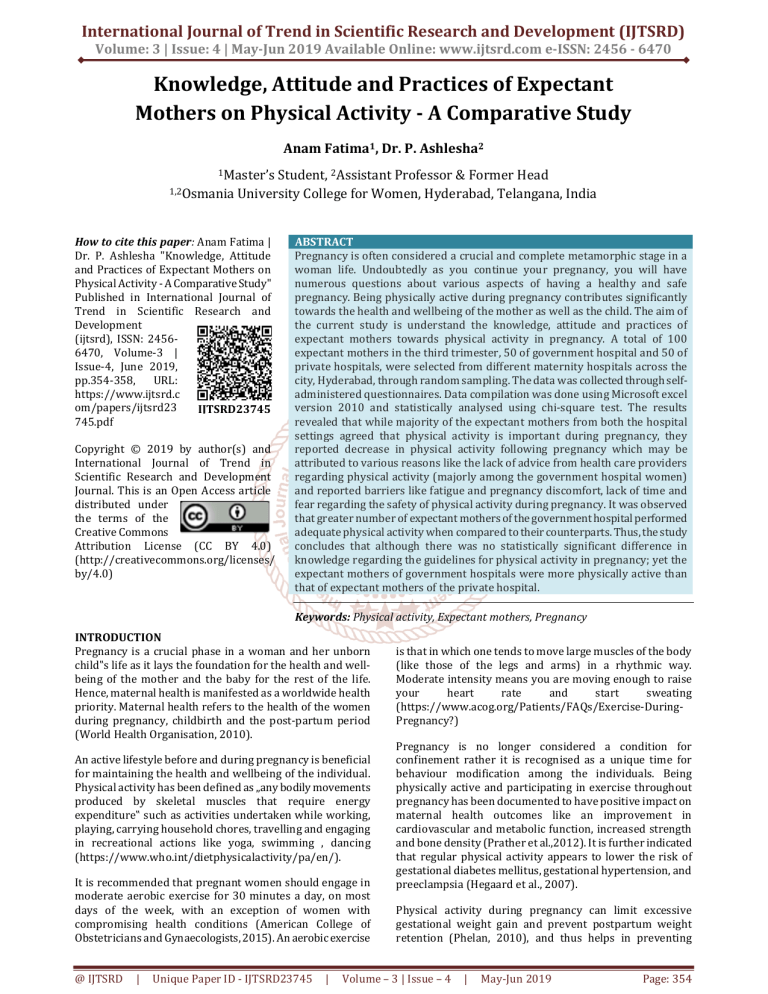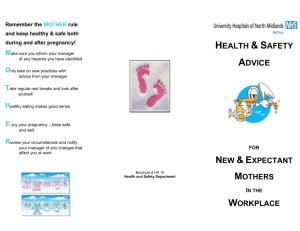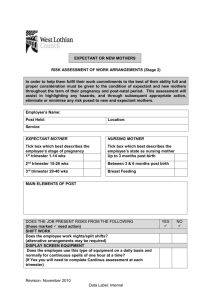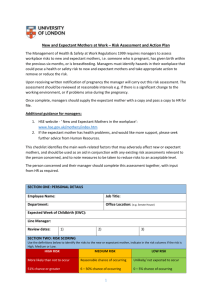
International Journal of Trend in Scientific Research and Development (IJTSRD)
Volume: 3 | Issue: 4 | May-Jun 2019 Available Online: www.ijtsrd.com e-ISSN: 2456 - 6470
Knowledge, Attitude and Practices of Expectant
Mothers on Physical Activity - A Comparative Study
Anam Fatima1, Dr. P. Ashlesha2
1Master’s
1,2Osmania
Student, 2Assistant Professor & Former Head
University College for Women, Hyderabad, Telangana, India
How to cite this paper: Anam Fatima |
Dr. P. Ashlesha "Knowledge, Attitude
and Practices of Expectant Mothers on
Physical Activity - A Comparative Study"
Published in International Journal of
Trend in Scientific Research and
Development
(ijtsrd), ISSN: 24566470, Volume-3 |
Issue-4, June 2019,
pp.354-358,
URL:
https://www.ijtsrd.c
om/papers/ijtsrd23
IJTSRD23745
745.pdf
Copyright © 2019 by author(s) and
International Journal of Trend in
Scientific Research and Development
Journal. This is an Open Access article
distributed under
the terms of the
Creative Commons
Attribution License (CC BY 4.0)
(http://creativecommons.org/licenses/
by/4.0)
ABSTRACT
Pregnancy is often considered a crucial and complete metamorphic stage in a
woman life. Undoubtedly as you continue your pregnancy, you will have
numerous questions about various aspects of having a healthy and safe
pregnancy. Being physically active during pregnancy contributes significantly
towards the health and wellbeing of the mother as well as the child. The aim of
the current study is understand the knowledge, attitude and practices of
expectant mothers towards physical activity in pregnancy. A total of 100
expectant mothers in the third trimester, 50 of government hospital and 50 of
private hospitals, were selected from different maternity hospitals across the
city, Hyderabad, through random sampling. The data was collected through selfadministered questionnaires. Data compilation was done using Microsoft excel
version 2010 and statistically analysed using chi-square test. The results
revealed that while majority of the expectant mothers from both the hospital
settings agreed that physical activity is important during pregnancy, they
reported decrease in physical activity following pregnancy which may be
attributed to various reasons like the lack of advice from health care providers
regarding physical activity (majorly among the government hospital women)
and reported barriers like fatigue and pregnancy discomfort, lack of time and
fear regarding the safety of physical activity during pregnancy. It was observed
that greater number of expectant mothers of the government hospital performed
adequate physical activity when compared to their counterparts. Thus, the study
concludes that although there was no statistically significant difference in
knowledge regarding the guidelines for physical activity in pregnancy; yet the
expectant mothers of government hospitals were more physically active than
that of expectant mothers of the private hospital.
Keywords: Physical activity, Expectant mothers, Pregnancy
INTRODUCTION
Pregnancy is a crucial phase in a woman and her unborn
child‟s life as it lays the foundation for the health and wellbeing of the mother and the baby for the rest of the life.
Hence, maternal health is manifested as a worldwide health
priority. Maternal health refers to the health of the women
during pregnancy, childbirth and the post-partum period
(World Health Organisation, 2010).
An active lifestyle before and during pregnancy is beneficial
for maintaining the health and wellbeing of the individual.
Physical activity has been defined as „any bodily movements
produced by skeletal muscles that require energy
expenditure‟ such as activities undertaken while working,
playing, carrying household chores, travelling and engaging
in recreational actions like yoga, swimming , dancing
(https://www.who.int/dietphysicalactivity/pa/en/).
It is recommended that pregnant women should engage in
moderate aerobic exercise for 30 minutes a day, on most
days of the week, with an exception of women with
compromising health conditions (American College of
Obstetricians and Gynaecologists, 2015). An aerobic exercise
@ IJTSRD
|
Unique Paper ID - IJTSRD23745
|
is that in which one tends to move large muscles of the body
(like those of the legs and arms) in a rhythmic way.
Moderate intensity means you are moving enough to raise
your
heart
rate
and
start
sweating
(https://www.acog.org/Patients/FAQs/Exercise-DuringPregnancy?)
Pregnancy is no longer considered a condition for
confinement rather it is recognised as a unique time for
behaviour modification among the individuals. Being
physically active and participating in exercise throughout
pregnancy has been documented to have positive impact on
maternal health outcomes like an improvement in
cardiovascular and metabolic function, increased strength
and bone density (Prather et al.,2012). It is further indicated
that regular physical activity appears to lower the risk of
gestational diabetes mellitus, gestational hypertension, and
preeclampsia (Hegaard et al., 2007).
Physical activity during pregnancy can limit excessive
gestational weight gain and prevent postpartum weight
retention (Phelan, 2010), and thus helps in preventing
Volume – 3 | Issue – 4
|
May-Jun 2019
Page: 354
International Journal of Trend in Scientific Research and Development (IJTSRD) @ www.ijtsrd.com eISSN: 2456-6470
numerous adverse maternal health outcomes. Physical
activity has also been associated with positive birth
outcomes like Shortened labour and a lower rate of
operative/instrumental delivery (Tinloy et al., 2014; Perales
et al., 2016). Studies have shown that regular exercise even
in the 3rd trimester neither leads to an increased rate of
premature delivery nor to increased hospitalisation (Barakat
et al., 2014; Tinloy et al., 2014). Moreover, physical activity
during pregnancy is found to impart positive effects on the
new-born in terms of long-term risk of chronic metabolic,
cardiovascular and oncological diseases (Blaize et al., 2015).
Despite the projected health benefits and guidelines for safe
excersing, very few women are found to be physically active
in pregnancy (Gaston and Vamos, 2013). Hence, it is crucial
to understand whether or not the pregnant mothers have
been sufficiently informed about the various dynamics of
physical activity during pregnancy. And if they have been
advised sufficiently, it is important to understand what are
the factors preventing them from exercising during
pregnancy.
In view of the above literature, the aim of this comparative
study is to examine the presence of any association between
the knowledge, perception and practice of physical activity
and thereby, study the barriers and promoters to physical
activity during pregnancy.
MATERIALS AND METHODS
A cross-sectional survey was conducted to examine the
knowledge, attitude and practice regarding physical activity
among the expectant mothers. A random sampling method
was employed to select the subjects. The subjects included a
total of 100 pregnant women in the third trimester form
both government (n=50) and private hospital (n=50),
Hyderabad. Pregnant women in the third trimester (18-37
years) were specifically selected because they would better
relate to the parameters under study and promptly describe
their attitudes and practices on these parameters throughout
the pregnancy period. A self-structured questionnaire was
employed to collect information like general information,
Anthropometric data-such as height and weight (weight at
two instances i.e. pre-pregnancy weight and present weight)
by using standard measuring scales and also the reports of
the patients.
aged 18-37 years, of whom 44% of expectant mothers of
government hospitals and 60% of the expectant mothers of
private hospitals were found to be nulliparous, while 56% of
expectant mothers of government hospitals and 40% of
private hospitals were multiparous.
The mean pre-pregnancy weight of expectant mothers from
government hospitals was 58.2 ± 11.2 Kg and that of private
hospitals was 61 ± 10.4 Kg, while the mean present weight
was about 71 ± 10.8 Kg in expectant mothers of government
hospitals and 74.3 ± 10.2 Kg in expectant mothers of private
hospitals.
Table-1: Socio-demographic details of the expectant
mothers
GOVERNMENT
PRIVATE
DETAILS
HOSPITAL
HOSITALS
LEVEL OF EDUCATION
No education
12%
0%
Primary
16%
2%
High school
34%
20%
Intermediate
26%
14%
Graduate or above
12%
64%
INCOME OF THE FAMILY
≤ 3 lakh/ yr.
78%
0%
3-10 lakh/ yr.
20%
40%
≥ 3 lakh/ yr.
2%
60%
OCCUPATION
Working
22%
32%
Non-working
78%
68%
Table-1 depicts that expectant mothers recruited from
government hospital had less education qualification; lower
annual income and majority of them were non-working. In
contrast to this setting, majority of expectant mothers from
private hospitals were well-educated, hadmiddle-high
income, and a greater percentage of them were working
when compared to their counterparts.
Information on Physical Activity was obtained by collecting
data (through self-structured questionnaire) on the physical
activity levels before pregnancy, perception about change in
activity due to pregnancy, awareness of the ACOG
recommended guidelines for physical activity during
pregnancy, the practice of physical activity, and also the
promoters and barriers to physical activity. The data
collected was consolidated using Microsoft excel (2010) and
subjected to statistical analysis using chi-square test.
Practice of physical activity: Expectant mothers who
performed physical activity as per the ACOG guidelines
(those who reported ≥30 minutes of PA per day for more
than 3 days a week) were considered to be performing
Adequate PA, while those who performed less than these
recommended levels were considered to be performing
Inadequate PA.
RESULTS AND DISCUSSION
A total of 50 expectant mothers of government hospitals and
50 expectant mothers of private hospitals were evaluated,
@ IJTSRD
|
Unique Paper ID - IJTSRD23745
|
Figure-1: Type of physical activity before pregnancy
Figure-1 shows that the expectant mothers of government
hospital were more physically active than their private
hospital counterparts before pregnancy. It shows that a
majority of women of private hospitals were found to be
performing sedentary work even before commencement of
pregnancy, with a very small proportion of women
performing moderate intensity work.
Volume – 3 | Issue – 4
|
May-Jun 2019
Page: 355
International Journal of Trend in Scientific Research and Development (IJTSRD) @ www.ijtsrd.com eISSN: 2456-6470
Figure-3 suggests that majority of the respondents of
government hospitals were not informed regarding the
importance and practice of physical activity during
pregnancy. In case of private hospitals, some of them
reported lack of provider advice but more than half said that
they were sufficiently informed regarding physical activity in
pregnancy.
Figure-2: Perception about change in physical activity
due to pregnancy
It is observed in figure-2 that the expectant mothers of
private hospitals were more likely to report that the physical
activity has changed following pregnancy, while a greater
number of respondents from government hospitals reported
no change in physical activity due to pregnancy. Of those
who reported change in physical activity due to pregnancy,
majority of them reported that there is a decrease in activity
levels in pregnancy. The outcome of this study supports the
study conducted by Astrid Merkx et al., (2017) on Factors
affectingperceived change in physical activity in pregnancy,
which indicated that more than half of the pregnant women
reported decrease in physical activity during pregnancy and
this perception was more pronounced in women who
considered themselves as more active before pregnancy.
Figure-4: Knowledge about the importance of physical
activity during pregnancy
Figure-4 represents that women from private hospitals
viewed physical activity as being important during
pregnancy more than their government hospital
counterparts. Among the women who reported that being
physically active during pregnancy is important, a greater
number of respondents reported that physical activity helps
to build stamina required for childbirth, while the benefit
that physical activity helps keep oneself fit and in good
health was least identified among the expectant mother. This
may imply that the expectant mothers are less concerned
about themselves and are more about the outcome of
pregnancy and the health of the baby.
Figure-3: Received health care provider advice on
physical activity during pregnancy
Table-2: Awareness regarding the recommended type of physical activity in pregnancy
Awareness Regarding Type Of Physical Activity
Type Of Hospital
T-Value
Result
Correct
Incorrect
Government hospital
9
41
0.006
Insignificant
Private hospital
17
23
Knowledge of private and government hospital respondents, with respect to recommended type of physical activity, is
insignificant with under p-value<0.05 with a t-value of 0.006. This indicates that respondents from both the types of hospitals
had no difference in knowledge with respect to the recommended type of physical activity in pregnancy.
Table-3: Practice of physical activity in pregnancy
Practice Of Physical Activity
Type Of Hospital
T-Value
Result
Adequate
Inadequate
Government Hospital
33
17
6.00
Significant
Private Hospital
13
37
Practice of physical activity, being adequate or inadequate,
among government and private hospital respondents, was
found to be significant under p-value<0.05 with a t-value
6.00. This indicates that the respondents of government
hospital performed physical activity more adequately when
compared to private hospital respondent‟s inspite of them
being less aware of the recommended guidelines for physical
activity during pregnancy. A study by Ribeiro and Milanez
@ IJTSRD
|
Unique Paper ID - IJTSRD23745
|
(2011) on Knowledge, attitude and practice of women in
Campinas, São Paulo, Brazil with respect to physical exercise
in pregnancy, depicts that pregnant woman believe that
physical activity is beneficial and were in favour of it, yet
only 20% of them were found to be performing adequate
physical activity during this period. These findings were in
agreement with the current study with respect to
respondents of private hospitals.
Volume – 3 | Issue – 4
|
May-Jun 2019
Page: 356
International Journal of Trend in Scientific Research and Development (IJTSRD) @ www.ijtsrd.com eISSN: 2456-6470
The study further elucidates that expectant mothers of
government hospital majorly practiced physical activity due
to health benefits it has on the child, but reported barriers to
physical activity like fatigue and pregnancy discomfort, and
lack of time. Contrarily, expectant mothers of private
hospitals practiced physical activity because of overall health
benefits to the mother as well as the child and also the
support offered to them, but reported barriers like fatigue
and pregnancy discomfort, and fear about the safety of
physical activity.
Figure-5: Promoters to physical activity in pregnancy
Figure- 5 indicates that health benefits to the child was
identified as the main driving force for being physically
active among the expectant mothers of government hospital,
while a majority of expectant mothers of private hospital
attributed not just one but all the listed promoters to be
equally important drivers to physical activity in pregnancy.
RECOMMENDATIONS
This study can be extended to a larger sample to get
more conclusive results.
The sample population could be given an education
intervention and the response of it may be studied.
ACKNOWLEDGEMENT
The authors fully acknowledge Dr. LATHA SASHI, Consultant
Nutritionist & HOD, Department of Clinical Nutrition and
Dietetics, Fernandez Hospital for providing her valuable
ideas and inputs on this project
BIBLIOGRAPHY
[1] ACOG Committee Opinion No. 650: Physical Activity and
Exercise during Pregnancy and the Postpartum Period.
Obstetrics & Gynaecology, 2015, 126(6), 135-142.
[2] Astrid Merkx, Marlein Ausems, Luc Budé, Raymond de
Vries, Marianne J. Nieuwenhuijze. Factors affecting
perceived change in physical activity in pregnancy.
Midwifery, 2017, 51:16-23.
Figure-6: Barriers to physical activity in pregnancy
Figure-6 depicts that fatigue and pregnancy discomfort,
followed by lack of time was identified as the major barriers
to the practice of physical activity in pregnancy. It is further
evident that expectant mothers of private hospitals are
avoiding exercise more frequently due to fear regarding the
safety of exercising during pregnancy.
A study by Ribeiro and Milanez (2011) on Knowledge,
attitude and practice of women in Campinas, São Paulo,
Brazil with respect to physical exercise in pregnancy shows
similar barriers being reported by pregnant women i.e.,
women reported tiredness, discomfort and lack of time as
the factors responsible for avoiding physical activity in
pregnancy.
CONCLUSION
The current highlights the need to inform the expectant
mothers on the recommended type/ intensity of physical
activity in pregnancy as majority of the women were
reported lack of knowledge or incorrect knowledge about
the recommendations of physical activity during pregnancy.
Moreover, it was reported that the health care providers did
not inform the pregnant women regarding physical activity
in pregnancy, particularly in government hospital. But
inspite of this deficit, it was observed that expectant mothers
of government hospital performed more adequate physical
activity than that of the private hospital women. This may be
due to lack of sufficient income to hire a domestic help by the
expectant mothers of the government hospital, unlike the
expectant mothers of the private hospitals.
@ IJTSRD
|
Unique Paper ID - IJTSRD23745
|
[3] Barakat R, Perales M, Bacchi M, Coteron J, Refoyo I. A
program of exercise throughout pregnancy. Is it safe to
mother and newborn? American Journal of Health
Promotion, 2014, 29(1):2-8.
[4] Blaize A N, Pearson K J, Newcomer S C. Impact of
maternal exercise during pregnancy on offspring
chronic disease susceptibility. Exercise and Sport
Sciences Review, 2015, 43:198–203.
[5] Carmen P.Ribeiro and Helaine Milanzer. Knowledge,
attitude and practice of women in Campinas, São Paulo,
Brazil with respect to physical exercise in pregnancy: a
descriptive study. Reproductive health, 2011, 8, 31.
[6] Gaston A and Vamos CA. Leisure-time physical activity
patterns and correlates among pregnant women in
Ontario, Canada. Maternal and Child Health Journal,
2013, 17(3), 477-484.
[7] Hegaard H K, Pedersen B K, Nielsen B B, Damm P.
Leisure time physical activity during pregnancy and
impact on gestational diabetes mellitus, pre-eclampsia,
preterm delivery and birth weight: a review. Acta
Obstetricia et Gynecologica Scandinavica, 2007,
86:1290–1296.
[8] Perales M, Calabria I, Lopez C., Regular exercise
throughout pregnancy is associated with a shorter first
stage of labor, American Journal of Health Promotion,
2016, 30:149–154.
[9] Phelan S. Pregnancy: a “teachable moment” for weight
control and obesity prevention. American Journal of
Obstetrics and Gynecology, 2010, 202(2): 135 e131–
138.
Volume – 3 | Issue – 4
|
May-Jun 2019
Page: 357
International Journal of Trend in Scientific Research and Development (IJTSRD) @ www.ijtsrd.com eISSN: 2456-6470
[10] Prather H, Spitznagle T, Hunt D. Benefits of Exercise
during Pregnancy. PM & R: the journal of injury,
function, and rehabilitation, 2012, 4, 845-850.
[11] Tinloy J, Chuang C H, Zhu J. Exercise during pregnancy
and risk of late preterm birth, cesarean delivery, and
hospitalizations. Women‟s Health Issues, 2014, 24: 99–
104.
@ IJTSRD
|
Unique Paper ID - IJTSRD23745
|
[12] Data on Maternal and reproductive health, Available
from: https://www.who.int/gho/maternal_health/en/.
[13] Physical
activity,
Available
from:
https://www.who.int/dietphysicalactivity/pa/en/.
[14] Recommendations on physical activity, Available from:
https://www.acog.org/Patients/FAQs/ExerciseDuring-Pregnancy?
Volume – 3 | Issue – 4
|
May-Jun 2019
Page: 358




